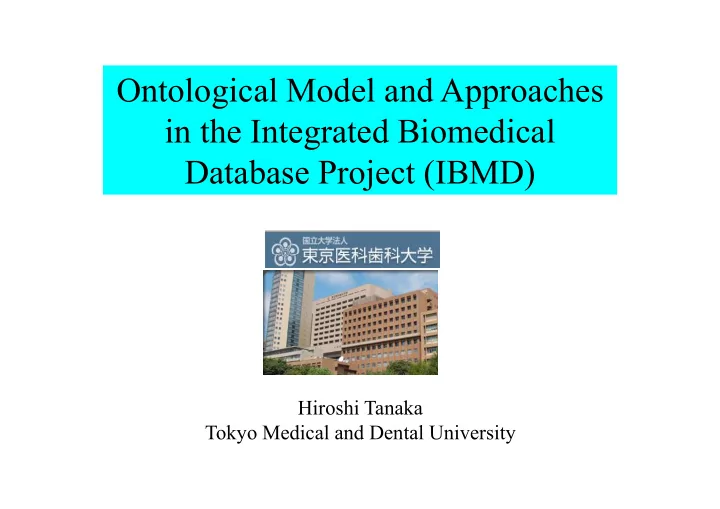

Ontological�Model�and�Approaches� in�the�Integrated�Biomedical� Database�Project (IBMD) Hiroshi�Tanaka Tokyo�Medical�and�Dental�University
What�is� the�Integrated�Biomedical�DB� project? project?
Integrated�Biomedical�DB�Projects • Government�commissioned�project – Started�at�2007�in� Tokyo�Medical�&�Dental�Univ. • by�MEXT�(Ministry�of�Education,�Culture,�Sports,� Science�and�Technology) Science�and�Technology) • A�subproject�of�the�National�Projects�for�DBs� integration�in�Life�science fields� • Main�goal�of�this�project�is integration�of�disease�databases�in�Japan
Biomedical�Ontology�Projects in�Japan • Two government�commissioned�medical� ontology�projects�in�Japan • Ours:�Scientific�DB�integration�by�MEXT • Clinical�Information�System�by�MHLW (Ministry�of�Health,Labour�and�Welfare) “Japan�Medical�Ontology�Development�Project� for�Advanced�Clinical�Information�System” – Dr.�Imai’s�talk • Good�collaboration�between�both�projects������
National�Project�for�DB�integration�in� Life�Science�Field�(MEXT) • Integrated�DB�Project�in�Life�Science – Started�from�2006 Background • DBs�in�LS�in�Japan�were�scattered�in�various�institutes – DNA�sequence�(DDBJ)�in�NIG�in�Mishima – DNA�sequence�(DDBJ)�in�NIG�in�Mishima – Protein�DB�(PDBJ)�in�Osaka�University – Pathway�DB�(KEGG)�in�Kyoto�University – Unlike�NCBI��in�US�and�EBI�in�Europe Goal • Establish�National�Center�for�DB�integration�in�LS���� (DBCLS) – develop�integrated�DB�service� – common�portals�for�DBs�in�LS
�����������������������������������
�������������������������������������
Allocation�Organization�for Integrated�DB�Projects • Tokyo�Medical�and�Dental�University�(TMDU)�,�� Information�Center�for�Medical�Science – commissioned�by�MEXT – to�integrate�scattered�databases�on�various�disease�in�Japan – to�be�a�National�Center�for�Disease�Database�Integration – to�be�a�National�Center�for�Disease�Database�Integration – from�2007,�Integrated�Biomedical�(clinical)�DB • Kyoto�University�Bioinformatics�Center – Integration�of�Drug�Information • Tokyo�University�Dept.�Human�Genetics – Integration�of�Genetic�Polymorphism
Challenges�for� Integrated�Biomedical�DB�projects • Development�of Ontology�based�Integrative� Interface�for�Disease�DB�search • Integration�of�the�Core�Clinical�DBs�in�Japan – Parkinson�Disease�DB�in�Osaka�Univ. – Parkinson�Disease�DB�in�Osaka�Univ. – GEMDBJ�in�National�Cancer�Center – So�on • Establish�Ethical�Code�for�Publicizing�Clinical� Case�DB
Then,�how�can�we�describe� Disease? Is�it�physical�entity,�or� Is�it�physical�entity,�or� just�conceptual ?
Disease�Modeling�in�Database� • What�is�the�ontological�characteristics� of�disease? social epidemiologica�l • Complexity�of�“Disease”� populational Prognosis� • Disease�is�a�multifaceted, Disease�progression beha behavioral Dise Disease Diagnostic�Therapeutic Diagnostic�Therapeutic multilayered�entity – molecular�genetic� Individual�observationa – tissue�organic� Organ�systems biological� – individual� tissue�organic – diagnostic�therapeutic�prognostic molecular�genetic – behavioral�(medical�practice)� – populational�epidemiological
Disease�Modeling�in�Database • Complexity�of�the�“Disease”� – Multi�faceted,�multi�layered�entity – Incompleteness�of�disease�knowledge – Multiplicity�of�related�sciences – Multiplicity�of�related�sciences • biological,�psycological,�behavioral,�conceptual,� social�science • Main�opposite�standpoints – Physical�vs�Conceptual – Causative�vs�Observational
How�do�we�describe�disease • Formal�Description�of�Disease • Disease�View�are�now�changing�since� Revolution�of�Molecular�medicine� Revolution�of�Molecular�medicine� • Conventional�View – Multilayered�Phenotypical�Description – Essentially�Observational – (Place,�Organ)�X�(Pathomorphology) • myocardial�(place)�infarction�(pathology)
Recent�Changes�of�Disease�View� • Advances�in�Molecular�Medicine – disease�genetics • disease�causative�(related)�gene • genetic�polymorphism�(SNP,�ms) • genetic�polymorphism�(SNP,�ms) SNPs SNPs – disease�omics� • genetic�expression�profile • proteome,�metabolome – disease�molecular�pathway • distorted�signal�pathway�or� regulatory�network DNA�microarray
Disease�is�hierarchically�organized� “ distorted�molecular�network ” ����������� ����������� Individual�Level Individual�Level Top&dow Bottom ottom&up�Causality �������������������� down�Causality ����������� ����������� Tissue Tissue& &Organ�Level Organ�Level ��������� ������������� ��������������!�� ��������������!��" Cellular�network�Level Cellular�network�Level ������������������� �������������!��"
Ontology • Formal�representation�of�a�set�of�concepts� within�a�domain�and�the�relationships�between� those�concepts� – used�to�reason�about�the�properties�of�that�domain,� and�to�define�the�domain� and�to�define�the�domain� – “Formal,�explicit�specification�of�a�shared� conceptualisation“�(Gruber,�kls�stanford) • Controlled�(Formal)�Vocabulary – used�to�model�a�domain�for�knowledge�sharing�and� reuse – the�type�of�objects�/concepts�that�exist,�and�their� properties�and�relations�
Challenges�in�Biomedical�Ontology Ontology�mismatch�between� clinical�thinking�and�Omics�medicine Information� Information • Each�information�system� system system has�its�ontology�as�a� basis basis terminology terminology • Mismatch�between� ontology ontology Clinical�ontology�and Bio&ontology Bio&ontology Clinical� Ontology
Mismatch�of�Thinking • Clinical�thinking� – Organs�and�diseases�are�units�of�concepts – Clinical�phenotypical;�disease�is�defined�on�pathological,� morphological�(changes)�base – Essentially�goal&oriented:�disease�care�directed – Essentially�goal&oriented:�disease�care�directed – Top�down • Molecular�(Omics)�medicine�thinking – Molecular�function�and�their�functional�relation�to�other� molecules – Products�of�gene�expression�are�units�of�concepts – Bottom�up
�!�������� Clinical�thinking�and� “ Omic�space ” Omic�space Omic�space Clinical�information� Clinical�information� symptomatology symptomatology Pathway Pathway signalome signalome networkome networkome Pathophsiology Pathophsiology Transcriptome Transcriptome Proteome Proteome metabolome metabolome Etiology Etiology Genome� Genome� SNP,�Haplotype SNP,�Haplotype #���������� ���
Existing�Clinical�and�Bio&Ontology • Clinical�ontology – Semantic�network,� UMLS,�Galen�(SNOMED) • Gene�Ontology� – Molecular�function,�process,�cellular�location�of� gene�products – Now�only,�Eukaryotes
Several�projects�for�Integration�of� Bio/Clinical�Ontology • Open�Biomedical�Ontologies�(OBO) – National�Center�for�Biomedical�Ontology�(Mussen)� – OBO�Foundry�(Smith) • Other�Projects • Other�Projects – Ontology�for�Biomedical�Investigations – ULMS�plans�to�involve�� Gene�Ontology – Disease�Ontology – So�on
Integrative�Clinico�Omic�Ontology (possible�transit�form) • Global�structure�follows� the�framework�of� clinical�ontology ��������$�������� %����!��" • Within�the�framework� • Within�the�framework� bio&ontology�is� manifes& therapy tations employed�to�provide� (drugs) (makers) bottom&up�relation�of� the�meaning�of� molecular molecular phenotypical�entities
Recommend
More recommend